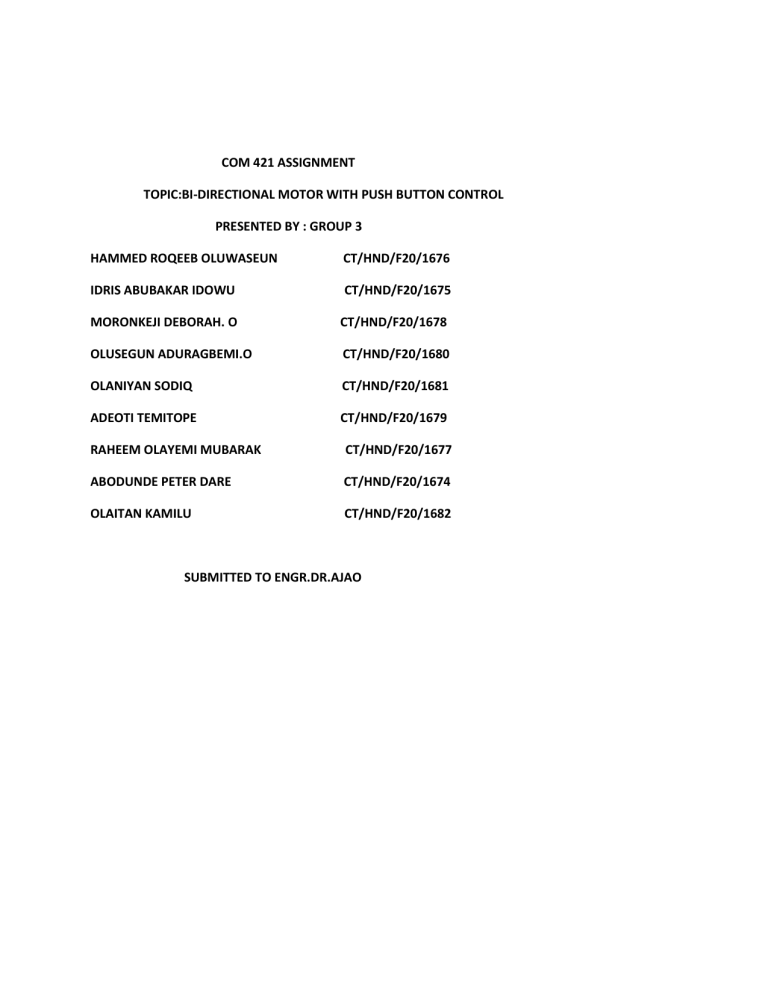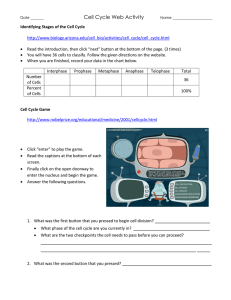
COM 421 ASSIGNMENT TOPIC:BI-DIRECTIONAL MOTOR WITH PUSH BUTTON CONTROL PRESENTED BY : GROUP 3 HAMMED ROQEEB OLUWASEUN CT/HND/F20/1676 IDRIS ABUBAKAR IDOWU CT/HND/F20/1675 MORONKEJI DEBORAH. O CT/HND/F20/1678 OLUSEGUN ADURAGBEMI.O CT/HND/F20/1680 OLANIYAN SODIQ CT/HND/F20/1681 ADEOTI TEMITOPE CT/HND/F20/1679 RAHEEM OLAYEMI MUBARAK CT/HND/F20/1677 ABODUNDE PETER DARE CT/HND/F20/1674 OLAITAN KAMILU CT/HND/F20/1682 SUBMITTED TO ENGR.DR.AJAO GROUP 3 TOPIC: BI-DIRECTIONAL MOTOR WITH PUSH BUTTON CONTROL BACKGROUND: The circuit shown below is of an 8051 based bi directional motor whose direction can be controlled using 2 push button switches. The circuit is very similar to the previous one except for the two push button switches . These pushbutton switches are interfaced to P0rt 3 of the microcontroller. Resistors R2 and R3 are the pull down resistors for P3.0 and 3.1 respectively. The code for the above project is so written that initially when power is switched ON, the motor remains OFF. When push button switch S2 is pressed P1.0 goes high and P1.1 remains low. The motor runs in the clockwise direction and this condition is maintained until S3 is pressed. When push button switch S3 is pressed the logic of P1.0 and P1.1 toggles making the motor to run in the opposite direction and this condition is maintained until the next press of S2. PROGRAM. ORG 00H // initiall starting address MOV P3,#00000000B // initiates P3 as the pushbutton interface MOV P1,#00000000B // clears P1 for keeping the motor OFF initially MAIN:MOV A,P3 // moves the current state of P3 to Accumulator CJNE A,#00000001B,LABEL1 // checks whether S2 is pressed MOV P1,#00000001B // makes the motor run clockwise LABEL1:CJNE A,#00000010B,LABEL2 // checks whether S3 is pressed MOV P1,#00000010B // makes the motor to run anti clockwise LABEL2:SJMP MAIN // jumps back to the MAIN loop END ABOUT THE PROGRAM. Checking whether a particular push button is pressed is done using the CJNE (compare and jump if not equal) instruction. In simple words the CJNE instuction compares two operands and jump to a predefined LABEL if the operands are not equal. If the two operands are equal nothing happens and the next instruction is executed. Whenever push button S2 is pressed the status of P3 will be 00000001B .This status is moved to accumulator A and compared with 00000001B using the CJNE instruction. Both operands are equal means S2 is pressed and the next instruction (MOV P1,#00000001B) which makes the motor run clockwise is executed. If the operands are not equal that means the S2 is not pressed and the controller jumps to LABEL1 which is to check the S3. To check S3, status of P3 is moved to A again and it is compared with 00000010B using the CJNE instruction. Both operands are equal means the S3 is pressed and the next instruction (MOV P1,#00000010B) which makes the motor run anti clockwise is executed. Both operands are not equal means S3 is not pressed and the controller goes to check S2 again and this cycle is repeated. OBSERVATION Assemble the circuit on a good quality PCB. The circuit can be powered from a 12V DC power supply. The IC1 must be mounted on a holder. The capacitor C1 must be rated at least 15V. The relay RL1 can be a 12V DPDT relay. CONCLUSION The maximum current capacity of L293 is 600mA/channel. So do not use a motor that consumes more than that. The supply voltage range of L293 is between 4.5 and 36V DC. So you can use a motor falling in that range. REFERENCE Https://www.circuitstoday.com Https://www.scribd.com Https://www.elprocus.com



